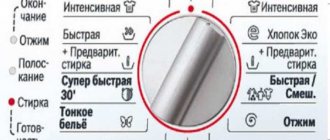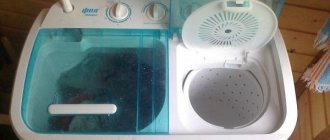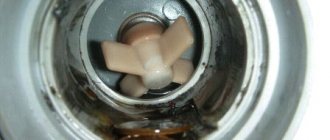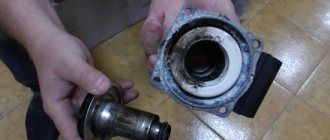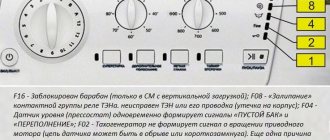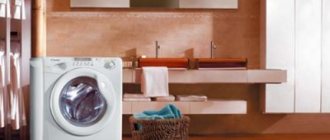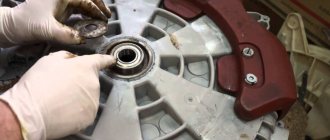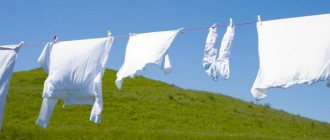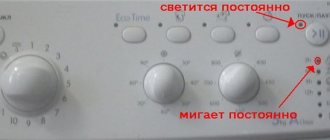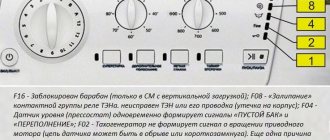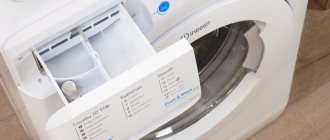Washing machines with the function of drying wet clothes appeared on the domestic market quite a long time ago , however, the devices failed to become widespread.
Many housewives still hang washed clothes on radiators or ropes, which takes a lot of time and also causes increased humidity in the apartment.
To get rid of the need to dry clothes after washing, you should take a closer look at functional devices for cleaning and drying various types of fabric.
You need to learn about the operating principle of such devices and the main selection criteria that will help you purchase the best model for your home.
Page navigation:
What is a washer dryer?
You should know! A washer-dryer is a multifunctional device that successfully combines the basic qualities of a washing machine and a dryer.
The electrical device is able to clean laundry from dirt and quickly dry it , while providing a slight smoothing effect, so that the user does not have to use the iron after removing dry items.
The appearance and dimensions of combined devices are no different from simplified machines.
However, the cost of washer dryers is slightly higher.
This is explained by the fact that the design is equipped with many additional options that greatly simplify operation and maintenance.
A washing machine with a drying function is an excellent option for those who do not want to spend money on expensive equipment and take up extra space with bulky structures.
Good equipment is expensive, you won’t be able to save money
A small washer and dryer will cost less than buying a washer and dryer. Of course, the energy consumption will be higher than when using a conventional machine, but this is more than compensated by the savings in time and effort. There is no need to hang things up and then take them down. After drying, you can immediately iron them, put them on or put them in a closet. Not all models have a high energy saving class, but today on the market you can already find machines with class A+++ dryers. Another important point is saving space. A narrow washing machine and dryer can easily fit even in a small room, while finding space for two units is not possible in every apartment.
Principle of operation
The main difference between improved devices for washing and drying clothes from standard models is the presence of a second heating element necessary to heat the air.
Stay up to date! The heating element is located behind the drum - during operation of the device, it rotates and shakes the loaded clothes, drying the fabric evenly.
During the process, built-in humidity sensors determine the degree of drying of the laundry . Condensing, the resulting moisture is drained into a separate tank.
Washer-dryers with the ability to connect to a drainage system do not have a container for collecting condensate.
Therefore, excess moisture goes into the sewer directly through the drain.
The drying function can be activated manually or automatically .
In the first case, the cycle duration is set at the user's discretion.
After the set time has elapsed, the machine shuts down.
Automatic devices are equipped with a thermometer sensor - it monitors the air temperature and humidity level.
Based on the data received, the system calculates the amount of moisture. As soon as the laundry humidity matches the set level, the cycle will stop.
Differences between a washing machine and dryer
The main difference between a standard unit and a 2-in-1 technique is obvious, i.e. the device combines an automatic washing device and a drying machine. Moreover, such a symbiosis involves an additional cycle - ironing.
However, users are often perplexed as to why they should purchase such a household appliance if things can dry well outside. Clean air gives clothes freshness, especially in frosty weather, without the use of chemicals. Of course, this statement occurs if the owner lives in a rural area and has free time. But for residents of megacities in a non-stop lifestyle, an automatic washing and drying machine is relevant.
Operating principle of the drying system
An electric heating element heats the air, and a pre-installed fan forces a flow that passes through the air duct into the tank with things. In addition, the drum with blades dries the laundry, preventing the formation of wrinkles.
For your information: experts have made a calculation, the result of which shows that even budget drying and washing equipment saves housewives up to 15 hours on average per month.
A number of models have built-in sensors responsible for monitoring the moisture level in clothes and a tank where condensation from water vapor released during drying is collected. The option can be specified by the user or triggered automatically. The principle of operation is that after three cycles, the drum continues to rotate at reduced speeds and at this time hot air masses enter.
Washing machine drying diagram
Drying modes
The first models assumed the inclusion of a program for drying clothes on a timer. Therefore, the user manually set the time, focusing on his own ideas about the required period.
It is noteworthy that this feature remains only in inexpensive representatives of the product line. Models in the mid-price segment and premium class are equipped with sensors and special modes.
Basic programs
The regulation of the process is based on the humidity of things, the level of which is determined by sensors. This approach makes it possible to obtain laundry that is not overdried, but with an optimal moisture content.
Common programs:
- fast, intensive for 100% water removal in 40-60 minutes;
- “Cupboard drying”, “gentle” take about 90 minutes, but the user receives things without wrinkles, drying out or damaging the pile.
Additional
The “iron” function involves steam treatment with periodic scrolling of items. As a result, the clothes look neat. Light ironing is allowed.
The dry wash option is used to process items without using water. This complex often includes the options “refreshing” and “sterilization”. Such methods of clothing care are relevant for homes where small children live, since the function allows you to eliminate germs and allergens.
Basic programs
Easy ironing mode
Drying technology
Manufacturers use several options:
- Condensation is a technology in which the air warms up, absorbs moisture and transfers it to a condensate collection tank. Moisture and heat are collected in the reservoir, after which the dried air masses penetrate the air duct and heating element, and then back into the drum. The disadvantage of this method is the increased water consumption.
If you leave the laundry slightly damp, the drying of the fabric fibers, and as a result, rapid wear, is reduced.
- Condensation without the use of water - in this case, a hot air stream passes through the heating element, collecting all the moisture from things and removing it into a separate container. In the tank, the air mass is cooled to room temperature due to the built-in fan, which draws air from the room. After this, the stream becomes dry and, passing through the heating element, enters the drum, and the condensate is discharged into the sewer. Thus, owners save on water.
- Timer - involves the user independently determining the type of fabric and choosing a program. The maximum operation period of the option is three hours.
- Residual moisture level or “smart drying” is a process in which the efficiency is higher compared to the previous option. The procedure is carried out using the built-in Fuzzy Logic sensor, which determines the level of humidity of clothing based on temperature and air indicators. The process ends when the optimum humidity is reached. It is noteworthy that the system involves the choice of 3 stages - iron, wardrobe, hanger.
Design
The complex design of the devices includes the following components, unlike a standard washing machine:
- Heating element - a built-in electric heating element heats the air.
- The blades installed in the drum rotate during the technological process. This reduces fabric breakage and wrinkling.
- A fan with an air outlet forces a flow through the air duct, transferring it into the drum with clothes.
- Humidity level sensors monitor the degree of readiness of products.
- The tank collects condensation that forms on the walls of the container, while the liquid settles in the compartment.
The option begins to operate (manual or automatic setting) after completing three cycles - wash, rinse, spin.
Advantages
Modern washer-dryers stand out among the variety of laundry cleaning devices on the market with many features and advantages.
It is worth noting! Experts and experienced users name the following points as the main advantages of multifunctional devices:
- no need to hang wet laundry;
- reducing humidity in the apartment;
- saving time and effort;
- compact body;
- the presence of a spacious tank ;
- careful handling of any fabrics;
- anti-crease;
- large selection of working programs;
- ease of maintenance and operation;
- intuitive interface;
- electronic leakage protection;
- reliability and quality of materials;
- acceptable price;
- long warranty period.
Flaws
Keep in mind! Despite the large list of advantages, washing machines with drying functions are not without disadvantages.
The disadvantages of such units are:
- inability to dry a full load of laundry at one time. After the washing is completed, the owner will have to transfer some of the items into the basin and activate the drying function again after some time;
- high energy consumption with a low energy efficiency class. Unlike single-tasking devices, most combined devices belong to class “B”, which means you shouldn’t count on saving energy resources.
Equipment for drying things
Externally, dryers look similar to washing machines. But unlike their competitors, drying machines are designed specifically for drying things, and therefore have a more thoughtful design and appropriate equipment. So, if you look at the drum, it is easy to see the obvious advantages.
- Increased diameter. On average, tumble dryers are 2.5 times larger than their washing counterparts, as free space is required for optimal ventilation.
- Special surface. High-quality drying requires uniform distribution of laundry along the walls of the tank, smoothing and unhindered penetration of air into the fabric structure. This becomes possible due to special perforation of the surface and other tricks and nuances of the drum.
- Internal lighting. With the help of lighting, the owner of the machine controls the degree of drying of the laundry.
The cost of individual drying machines starts from 18-20 thousand rubles, while among multifunctional machines you can find a model for 15 thousand rubles.
A separate machine also wins in the number of programs offered by the system. As a rule, a standard dryer has more than ten modes of varying duration and intensity of exposure to hot air. So, the user can select a cycle for synthetics, cotton, sports items, woolen items, or even more clothes, or turn on accelerated drying. The owner will also be pleased with the availability of additional options - steam treatment, ironing effect and wrinkle prevention.
Often, special baskets and other devices are included with the dryer to reduce the risk when drying shoes, textile bags, plush toys and items made from delicate materials. At the same time, the machines are not without modern features - a digital display, delayed start, child protection or remote control using a smartphone.
The main advantage of a dryer is its specialization. If an integrated approach to drying clothes is important, then it will be the best option. But there are also disadvantages - the high price and the need to look for free square meters. The latter problem can be solved by choosing a model with the possibility of installation in a column.
“Two in one” sounds nice, but in everyday life, multifunctional machines are clearly inferior to their direct competitors. More expensive and larger drying machines handle drying more efficiently and easily, without creating unnecessary risks and problems with wet laundry that does not fit into the drum. It remains to decide what is more important: savings, comfort or careful treatment of linen.
Interesting:
- How to choose a clothes dryer?
- Dryer reviews
- How to use a tumble dryer?
- Washer dryer reviews
- Secrets of choosing a washing machine with dryer
- Built-in washing machine and dryer
Reader comments
- Share your opinion - leave a comment
Basic selection options
When choosing a washer-dryer, experts recommend paying special attention to the technical characteristics of the models in question .
Having studied the basic parameters, even an inexperienced user can purchase the best device without spending extra money.
Let's review all the parameters to figure out how to choose a device.
Energy consumption
Important! An economical device can be easily recognized by the “A” marking with any number of pluses on the packaging, which indicates minimal energy consumption.
Finding an economical washer dryer is not an easy task.
But in the lines presented by well-known manufacturers, you can find devices whose operation will not cause additional costs.
Washing and spin class
For washing and drying machines, washing and spinning classes are determined - from “A” (economical) to “G” (wasteful).
Manufacturers strive to improve the quality of their products; for this reason, in the household appliances market you can increasingly find models belonging to class “A”, “B” or “C”.
Less common are devices belonging to class “D”.
Drying technology
Note! In modern washing machines, drying can be of several types:
- condensation The heated air that has absorbed moisture passes through a condenser, which uses cold water to dry it. Having lost heat and moisture, the air re-enters the laundry drum through the air duct and heater. The technology is characterized by increased water consumption;
- condensation without water. The hot air passing through the heating element extracts moisture from things and enters a separate tank, where it is cooled to room temperature. The dry air then passes through the heating element again and returns to the drum. The accumulated moisture goes down the drain. Water is used sparingly with this method;
- according to the degree of residual moisture. The device is equipped with a special sensor and a smart system that can determine the moisture content of laundry based on air temperature and humidity. When the preset humidity is reached, drying stops:
- by timer. The owner has the opportunity to independently select and set the drying mode, as well as determine the fabric that needs to be dried. The maximum drying time is usually no more than three hours.
Washing and drying programs
For your information! Expensive models and devices from the mid-price segment are equipped with a large number of operating programs.
And these programs will help you wash and dry clothes made from various materials, maintaining color and shape.
Budget devices are equipped with a smaller set of modes , which does not affect the washing efficiency, but significantly limits the capabilities of the device.
Dimensions
The dimensions of the device are one of the most important parameters that you need to pay attention to first.
Washing and drying units usually do not take up extra space, since their width can vary from 55 to 60 cm, height from 80 to 85 cm, and depth from 45 to 65 cm.
However, you need to decide in advance on the installation location and make sure that the chosen model is suitable.
Load capacity and weight
In drying mode, combined machines are capable of drying no more than half of the total capacity of the device.
Remember! If you need to wash a large amount of clothes, it is better to purchase a spacious model with a load capacity of at least 9 kg.
For a small family or individual use, a device designed for 6-7 kg would be an excellent option.
Built-in or freestanding
Having given preference to built-in equipment , it is important to take into account its parameters, since the device must fit perfectly into the location chosen for installation.
Free-standing devices often do not require strict calculations, because they are easier to install.
Vertical or front loading
The difference between different types of washer-dryers lies in the location of the loading hatch.
For front-loading electrical appliances, the hatch is located in the center of the front wall and opens to the side up to 180 degrees.
When the wash starts, the hatch is blocked using an electronic lock.
In devices with vertical loading, the hatch is located on top . Below it is a horizontal drum with a door that has a conventional mechanical lock.
For reference! During the washing process, the user can add forgotten items, however, it will not be possible to observe the operation of the device due to the opaque panels.
How does a dryer work?
The concept of drying is to treat things not with foamy water, but with hot air. Things are blown, moisture accumulates in the condensation tank or is discharged into the sewer. Dryers have a lower number of revolutions: this is necessary so that things do not wrinkle during the drying process. Their number depends on the device itself and its modes: dryers spin the slowest in the delicate items mode.
Dryers specialize exclusively in drying clothes. They can neither wash nor wash. But washer-dryers can do both.
The drum of a dryer is twice as large as that of a washing machine. Such a substantial volume is needed so that things can be immediately put into the closet, bypassing the ironing stage.
Capacious units hold from 7 kg. For a washer and dryer - from 5-6 kg. Therefore, it will process less clothes. And if you take 7 kg and above, there will be excess water consumption if you need to wash and bring to mind only a few clothes.
Read: 5-point instructions on how to properly ground a washing machine with your own hands
Useful functions of the dryer: table
| Function | Features, what is it for |
| Laundry moisture control | You can set the desired level of humidity. |
| |
| |
| Anti-crease | The machine combines drum reversal and steam ironing |
| Drying down items | Does not crumple when drying |
| Drum reverse | To prevent laundry from bunching up |
| Steam ironing | Prevents creases, disinfects and gives freshness. Gorenje DS92ILS has this function |
| Condensate drain system | Moisture accumulates in a container that is connected to the sewer. There are autonomous condensing models - where the container is not connected anywhere. Accumulated moisture is drained after each wash. |
| Programs for different types of fabrics | A regime that suits jeans will tear silk underwear. Therefore, the more programs provided, the better. |
Note: Why the water does not drain from the washing machine - 5 ways to drain the water manually
What additional features should I pay attention to?
Depending on the needs of the user, various additional options and the availability of special programs may be necessary to help make quality care for your favorite clothes simple and enjoyable.
Functions such as:
- foam level control , which is draining the water and removing the resulting foam after the cycle is completed;
- delayed start , allowing you to start washing at a time convenient for the owner of the device;
- child safety lock is an option that ensures safe operation, which a family with a baby cannot do without;
- quick wash, which will help you wash and dry items without creasing in just 60 minutes;
- night mode, which guarantees silent but effective washing and drying of clothes.
Stay up to date! You cannot do without special programs for delicate fabrics, outerwear, sports shoes, wool and silk.
Popular manufacturers
The best manufacturers of washer-dryers are:
- Hotpoint-Ariston is one of the world's largest manufacturers of home appliances, known for the quality of its products. Among the variety of models developed by the company, the following stand out:
- FDD 9640 B;
- RDPD 96407;
- AQD 1070D 49;
- AQD 1071D 69.
- Bosch is a German company that is a leading provider of technology and services in the consumer products industry. The manufacturer provides a wide range of washing and drying machines, but the most popular are:
- WDU 28590;
- WVG 30461;
- WVH 28442;
- WVG30460PL.
- LG is a South Korean company that produces functional household appliances for a comfortable life. Experts recommend purchasing:
- F-1296CD3;
- FH-2G6NDG2;
- F-1496AD3;
- F2J6NM0W.
conclusions
When planning to purchase a washing machine with drying function, you should remember that:
- when choosing the best model, first of all you should pay attention to the energy consumption class, drying technology, dimensions and capacity of the drum ;
- It is also necessary to take into account the type of download , choosing in advance the most convenient option for yourself;
- additional functions increase the cost of the electrical appliance , but their presence will make working with the machine simple and comfortable.
Washing machines and dryers are never narrow and take up a lot of space.
Until recently, there were no such models on the domestic market. Today, a 45 cm deep washer-dryer is represented in the product lines of several brands (for example, CANDY, LG). Many well-known brands have models with a depth of up to 55 centimeters. Compact washing machines and dryers easily fit into even a small bathroom and take up little space. Despite their modest dimensions, in the washing mode they are designed for 3-4 kilograms of laundry, which is quite enough for a small family. Many models are equipped with a large number of additional functions.
